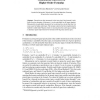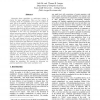CADE
2010
Springer
14 years 29 days ago
2010
Springer
It has recently been shown that proofs in which some symbols are colored (e.g. local or split proofs and symbol-eliminating proofs) can be used for a number of applications, such a...
CADE
2010
Springer
14 years 29 days ago
2010
Springer
Abstract. In the context of deductive program verification, supporting floatingpoint computations is tricky. We propose an expressive language to formally specify behavioral proper...
CADE
2010
Springer
14 years 29 days ago
2010
Springer
Abstract. Focused proof systems provide means for reducing and structuring the non-determinism involved in searching for sequent calculus proofs. We present a focused proof system ...
CADE
2010
Springer
14 years 29 days ago
2010
Springer
In order to support the verification of programs, verification tools such as ACL2 or Isabelle try to extract suitable induction axioms from the definitions of terminating, recursiv...
CADE
2010
Springer
14 years 29 days ago
2010
Springer
Abstract. Formulas are often monotonic in the sense that if the formula is satisfiable for given domains of discourse, it is also satisfiable for all larger domains. Monotonicity i...
CADE
2010
Springer
14 years 29 days ago
2010
Springer
Abstract. We introduce a semantics for classical logic with partial functions. We believe that the semantics is natural. When a formula contains a subterm in which a function is ap...
LPE
2003
14 years 1 months ago
2003
The Prolog programmer’s needs have always been the focus for guiding the development of the SWI-Prolog system. This article accompanies an invited talk about how the SWI-Prolog e...
JFPLC
2003
14 years 1 months ago
2003
ABSTRACT. We present PICPA, a new algorithm for tackling constrained continuous multiobjective problems. The algorithm combines constraint propagation techniques and evolutionary c...
ICAI
2003
14 years 1 months ago
2003
Reasoning about capabilities in multi-agent systems is crucial for many applications. There are two aspects of reasoning about the capabilities of an agent to achieve its goals. O...
LPE
2001
14 years 1 months ago
2001






